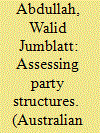| Srl | Item |
| 1 |
ID:
146528


|
|
|
|
|
| Summary/Abstract |
This article attempts to answer the puzzle of why, amongst undemocratic states, some regimes are more authoritarian than others. The author contends that differing party structures result in different authoritarian outcomes. A ruling, competitive authoritarian regime that has a party structure akin to a cadre party, or where there is little or no intra-party democracy, is more likely to be more authoritarian than a party which has intra-party democracy. The lack or absence of intra-party democracy ensures that elites remain cohesive and that there are lesser opportunities for the opposition to take advantage of divisions in the party, whereas in a party with intra-party democracy, there is a greater possibility of elite disunity, which could be capitalised on by the opposition, and there is also a greater likelihood of a different ideology being propagated by defectors from the party. The cases of the People's Action Party in Singapore and the United Malays National Organization in Malaysia are used to illustrate the author's case.
|
|
|
|
|
|
|
|
|
|
|
|
|
|
|
|
| 2 |
ID:
145821


|
|
|
|
|
| Summary/Abstract |
Using the test cases of Afghanistan and Iraq, this study illustrates how alliances work to mitigate the conflicting frames that party structure and media access provide in the Global War on Terror, which leads to more cohesiveness in the North Atlantic Treaty Organization (NATO)–led coalition in Afghanistan as opposed to the U.S.-led coalition in Iraq. The approach utilized here extends the theory on alliance capability and uncertainty by arguing that alliances reduce uncertainty among member states on a strategic objective. This is particularly relevant when examining asymmetric, limited conflicts, where party structures and media access can work to disseminate conflicting frames to a domestic populace, who then can pressure their leader to withdraw from a coalition. The implications of these findings lend support to the continued relevance of NATO in the twenty-first-century security arena.
|
|
|
|
|
|
|
|
|
|
|
|
|
|
|
|